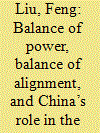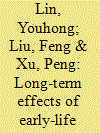|
|
|
Sort Order |
|
|
|
Items / Page
|
|
|
|
|
|
|
| Srl | Item |
| 1 |
ID:
190663


|
|
|
|
|
| Summary/Abstract |
The Indo-Pacific region has become a central focus of great power competition. Not surprisingly, a rising China seeks to play an important, if not a leading role in the transformation of Asia’s present regional order. The United States, meanwhile, as the unipole, has strong incentives to prevent the rise of a peer competitor. Facing certain structural and domestic constraints, China is disinclined to resort to the strategy of violent revision or subversion historically pursued by previous rising powers. Instead, China has pursued a gradual change of the existing regional order through a combination of internal balancing and external reassurance strategies. Specifically, China’s quest for great power status in the region, particularly in response to the Indo-Pacific strategy adopted by the United States since the Trump administration, has prompted its proactive shift to counterbalance the US’ vision of order in the region. This paper argues that the balance of power and the balance of alignment constitute two key variables that affect the prospect of Sino-US competition for a preferable regional order. Beijing’s balancing strategies have significantly enhanced its economic and military capabilities, reducing the gap with the United States on the one hand and attracted certain regional states to join China-led regional initiatives on the other. However, owing to the complex balancing dynamics in the region and the agency of small and middle powers, the balance of alignment supports neither American nor Chinese dominance of Asia. Contrary to the ‘new Cold War’ narrative, the contest for order does not entail dividing the region into two rival blocs, but rather creating certain overlapping groupings and coalitions led by the two great powers. It consequently also signifies that the current order transition under a new bipolarity will be prolonged and relatively stable compared to the Cold War bipolarity.
|
|
|
|
|
|
|
|
|
|
|
|
|
|
|
|
| 2 |
ID:
168511


|
|
|
|
|
| Summary/Abstract |
A dualistic-order thesis has been emerged as a widely-used concept to describe East Asia’s regional dynamics. According to the thesis, the economic and security spheres of the region have become divorced from one other, whereby China and the United States dominate the economic and security realms, respectively. This paper demonstrates the deficiencies of this thesis, based on a comprehensive assessment of the economic and security developments in the region, as well as the strategic choices of small and middle regional powers. In order to form a more accurate and systematic understanding of regional prosperity and stability, this paper develops an economy-security nexus approach by integrating the interactions of regional actors in both the economic and security realms into a unified framework. From this perspective, East Asian regional order is sustained by a delicate coupling of regional economic and security configurations: ‘hot economics’ is accompanied with cooperative security interactions. Although China and the United States are not the dominant actors in either field, their relatively benign interactions in both realms collectively play a significant role by shaping the strategic environment for regional actors, allowing them to enjoy a large degree of strategic flexibility and increase their security and prosperity.
|
|
|
|
|
|
|
|
|
|
|
|
|
|
|
|
| 3 |
ID:
120795


|
|
|
|
|
| Publication |
2013.
|
| Summary/Abstract |
After the end of the Cold War, East Asia did not enter a period fraught with tension and conflict, but surprisingly maintained a relatively long period of peace. The existing literature on the East Asian security order mainly emphasizes structural or processual factors, but these approaches cannot provide an adequate explanation of the interior dynamics and mechanisms of the East Asian security order. The main reasons for the inherent instability in the current system are still unclear. In this paper, the author presents a functionalist explanation and argues that the United States and China's separate provision of the two most important public goods-security expectations and economic benefits-laid the foundation for the current security order in East Asia. However, with the rise of China and the U.S. pivot toward Asia, supplying these two types of regional public goods becomes more difficult than it was previously, and this new scenario will cause instability in the existing order.
|
|
|
|
|
|
|
|
|
|
|
|
|
|
|
|
| 4 |
ID:
171524


|
|
|
|
|
| Summary/Abstract |
A widespread implicit assumption is that renewable energy options are approximately low-carbon. However, production and life cycles of such technologies tend to produce CO2 emissions. To minimize life-cycle emissions, one should account for such emissions and implement adequate policies to encourage innovation and adoption of well-performing technologies in this respect. We develop a framework to analyse this issue, grounded in the concepts of ‘energy return on energy invested’ (EROI) and ‘net energy return on carbon invested’ (EROC). Applying these to the main PV technologies and production regions – namely China, EU and USA – displays considerable discrepancies. We conditionally predict the development of average EROI and EROC over time under business-as-usual and low-carbon electricity generation scenarios. A main policy lesson is that without a systemic policy instrument, such as carbon pricing, incentives for low-carbon production of renewable energy options are too weak, which likely will delay a complete transition to a low-carbon economy.
|
|
|
|
|
|
|
|
|
|
|
|
|
|
|
|
| 5 |
ID:
182800


|
|
|
|
|
| Summary/Abstract |
This study evaluates the long-run effects of early-life exposure to tropical cyclones on the socioeconomic performance of individuals in China. We identify significantly negative effects of gestational typhoon exposure on the educational attainment and annual income in adulthood, which also exhibit a significant gender inequality favoring the male. Despite the small culling effects from pregnancy failure and infant mortality, gestational typhoon exposures increase the probability of having a younger sibling and shorten the subsequent birth interval. Typhoon damage to the health and economic abilities of adults, as well as the local economy indicates a channel of household economic status for the reduced long-run socioeconomic outcomes.
|
|
|
|
|
|
|
|
|
|
|
|
|
|
|
|
| 6 |
ID:
099421


|
|
|
|
|
| Publication |
Washington, DC, World Bank, 2010.
|
| Description |
xviii, 156p.
|
| Standard Number |
9780821381229
|
|
|
|
|
|
|
|
|
|
|
|
Copies: C:1/I:0,R:0,Q:0
Circulation
| Accession# | Call# | Current Location | Status | Policy | Location |
| 055303 | 363.7387460972/JOH 055303 | Main | On Shelf | General | |
|
|
|
|
| 7 |
ID:
176236


|
|
|
|
|
| Summary/Abstract |
In response to the changing geopolitical landscape in Asia, both China and the United States attempt to alter the regional order in their own favour, both in the economic and security realms. This article shows how diverging views on future arrangements are leading to strategic shifts and increasing tension between these two Great Powers. As part of its quest for Great-Power status, China has been actively pushing its regional initiatives such as the Belt and Road Initiative (BRI) and the Asian Infrastructure Investment Bank (AIIB), as well as adopting assertive security policies towards its neighbours. In contrast, in order to counter China's growing influence America's regional strategy is undergoing a subtle shift from ‘rebalancing to Asia’ to focusing on the ‘Indo-Pacific’ region. However, amid an intensifying trade war and other challenges facing the region, China has chosen to moderate its proactive foreign policy-orientation in the past few years. In particular, China has made attempts to downplay its domestic rhetoric, rebuild strategic relationship with India and Japan, and to reassure ASEAN states in the South China Sea. In response to the Indo-Pacific strategy, it would be more effective for China to articulate a more inclusive regional vision and promote an institutional framework that also accommodates a US presence in the region.
|
|
|
|
|
|
|
|
|
|
|
|
|
|
|
|
| 8 |
ID:
193763


|
|
|
|
|
| Summary/Abstract |
Entrepreneurs and entrepreneurship are essential for new wealth creation and economic growth, particularly in developing countries. The objective of this study is to develop a model to identify the determinants of entrepreneurship, and reveal how it can be predicted based on individual characteristics, family environment, and social environment. Employing 16 sets of machine learning algorithms on data collected from the Chinese General Social Survey in 2017, we find the best-performing algorithms (i.e., lasso, ridge, and elastic net regression) and examine the effects of the feature variables on entrepreneurship. Overall, this study provides significant theoretical underpinnings for entrepreneurship research, and offers insights for individuals and policymakers by revealing various drivers of entrepreneurship.
|
|
|
|
|
|
|
|
|
|
|
|
|
|
|
|
|
|
|
|
|